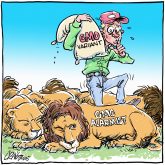Supply management defends food sovereignty
The recent federal election revealed strong public support for maintaining Canadian sovereignty. A vital component of that sovereignty is control over our food supply.
The Western Producer article, “Supply management will soon become the centre of attention,” on page 7 of the May 8 issue highlights a troubling shift.
Read Also

High prices see cow-calf producers rushing to incorporate
Farm accountants are reporting a steady stream of cow-calf producers rushing to get their operations incorporated ahead of selling their calves this fall.
It suggests using Canada’s supply management system — particularly dairy — as a bargaining chip in trade negotiations with the U.S., arguing this could “modernize” the system. What the article omits is the devastating effect of the U.S. free-market model on its own farmers. Since 1997, the U.S. has lost nearly 70 per cent of its family-scale dairies.
Critics claim Canadian consumers are overpaying due to supply management. Not true.
Comparing retail prices, American consumers pay 16 per cent more for milk, 60 per cent more for eggs and double for cheese than Canadians. Meanwhile, American dairy farmers are being driven out of business, and corporate agribusinesses are consolidating control.
Yes, Canada’s quota system limits rapid expansion, but it also allows farmers to remain viable without government bailouts or bankruptcy. In contrast, the U.S. model rewards corporate concentration while consumers pay higher prices.
Canadian negotiators must not allow the supply management system to be dismantled. It serves both farmers and consumers.
The real pressure to dismantle comes from corporate interests and their consultants — not from Canadians.
If we lose supply management, we lose the foundation of food sovereignty. And if supply management is gone, rebuilding it will be next to impossible.
My message: elbows up for sovereignty.
Murray Hidlebaugh, Saskatoon, Sask.
Wetland drainage threatens wildlife
May 10 was Migratory Bird Day, a day to recognize and celebrate our feathered friends that have travelled thousands of kilometres to return to the Prairies or continue their journey farther north.
Making nonstop flights across vast distances, some birds, like the tiny semipalmated sandpiper, fly more than 5,300 km from South America to Canada.
Prairie wetlands are unique and crucial stopover points for migratory birds, offering a place to rest, feed and refuel during their long journeys.
Like fast food restaurants along the migration highway, the shallow waters and vegetation provide abundant food in the form of insects and aquatic plants.
Once the spring migration is over, these biodiversity hotspots become critical nesting and foraging sites for a wide range of breeding bird species, from songbirds to waterfowl and shorebirds.
But what happens when those breeding sites are gone? When migrating birds need to stop to refuel and rest and they find the wetlands they rely on have been drained?
Habitat loss due to agriculture and urban development are major threats to prairie wetlands and the birds that depend on them.
On the northern Great Plains, we lose on average one acre of grassland every minute, and in Saskatchewan we have already lost 50 per cent of our wetlands. Sadly, wetlands and the birds that rely on them are both in decline, and some bird species have lost over 90 per cent of their Canadian populations.
Like the canary in a coal mine, birds are indicators of the health of our environment and our Prairie ecosystem. But rather than protecting wetlands, a new drainage policy by Saskatchewan’s provincial government will speed up the declines of wetlands and birds, allowing on average 85 per cent of a region’s wetland area to be drained to grow more grain.
Saskatchewan’s wetlands are a unique feature of our Prairie landscapes. They are part of our heritage and shared responsibility as citizens, not the private property of large landowners wanting to increase cropping acreage.
We need policies that support farmers to adopt sustainable farming practices and conserve wetlands, not policies that provide millions of taxpayers’ dollars to drain them.
We, like the birds, need Wetlands for Tomorrow. To learn more, follow us on Facebook.
Trevor Herriot, Regina
Health-care bill threatens rural Alberta
Most farmers I know believe in taking care of their own, keeping the government out of what it can’t run well and speaking up when something doesn’t sit right.
That’s why Alberta’s Bill 55 deserves a closer look.
This bill wipes out the province’s regional health authorities — the local boards that used to give rural communities a say in how health care was delivered.
In their place, it installs centralized “provincial health corporations,” run out of Edmonton, with no requirement to consult or listen to anyone on the ground.
That means your nearest ER, ambulance service or rural clinic could be restructured without your town council — or your MLA — even knowing it’s happening. That’s not less government. That’s more power in fewer hands.
The health minister says no one will pay out of pocket and that this isn’t about privatization. But you don’t need to change the billing system to open the door to private contracts.
When decisions about rural care are made by people who’ve never stepped foot on your land, it’s only a matter of time before “cost efficiency” means cutting services out here and bringing in outside providers.
Rural folks already get the short end of the stick in health care. Bill 55 makes that worse, not better.
This isn’t reform — it’s removal of our voice. Let’s remind our MLAs that their job is to represent us, not rubber-stamp top-down changes that leave their own communities behind.
Samantha Mertler, Stony Plain, Alta.














